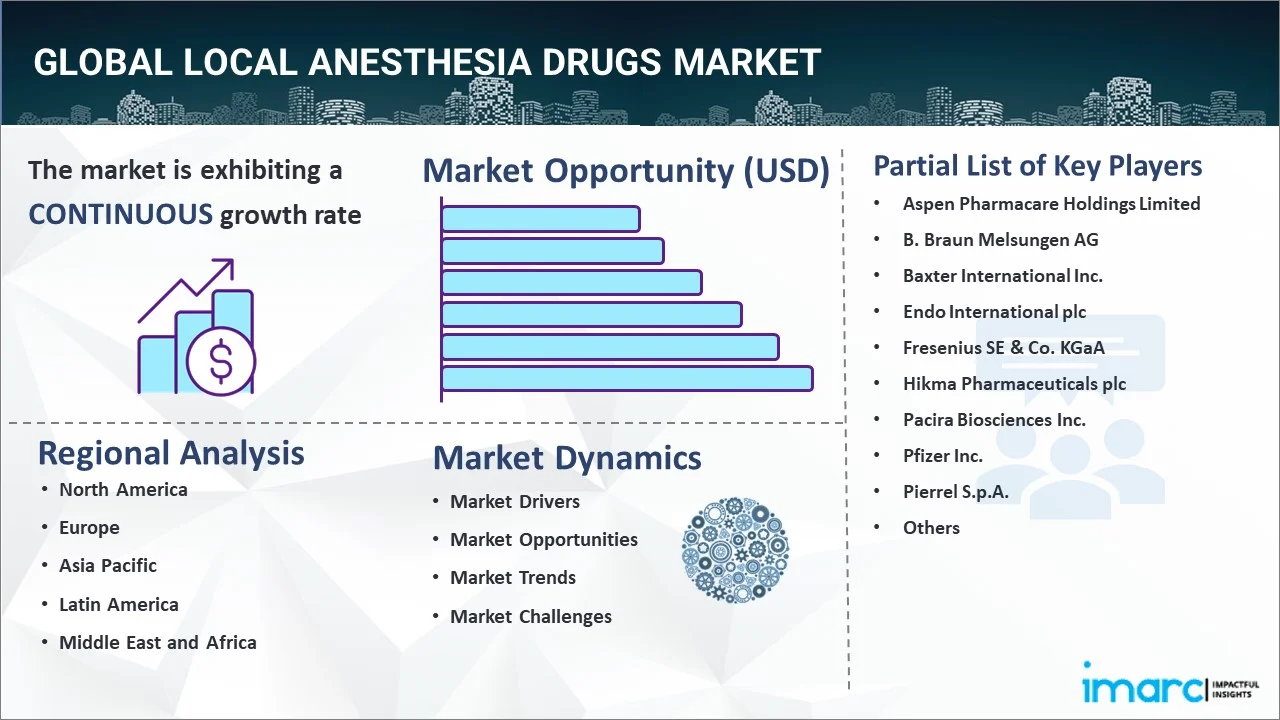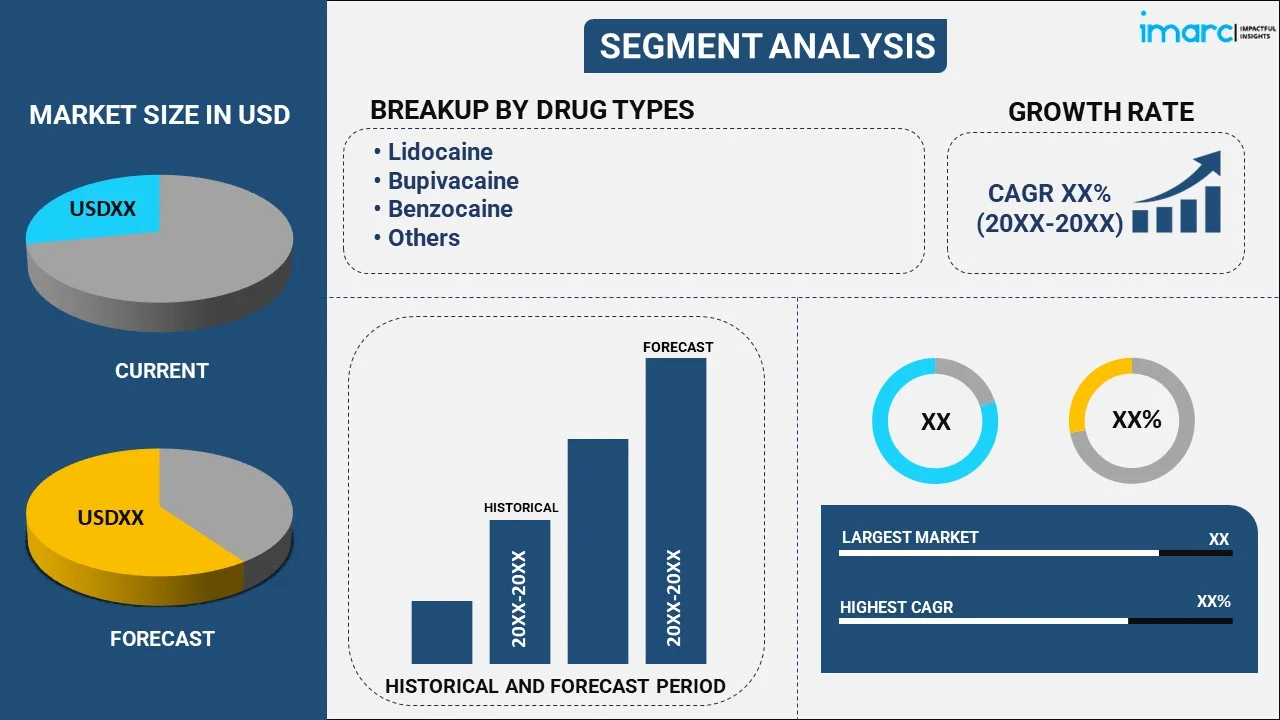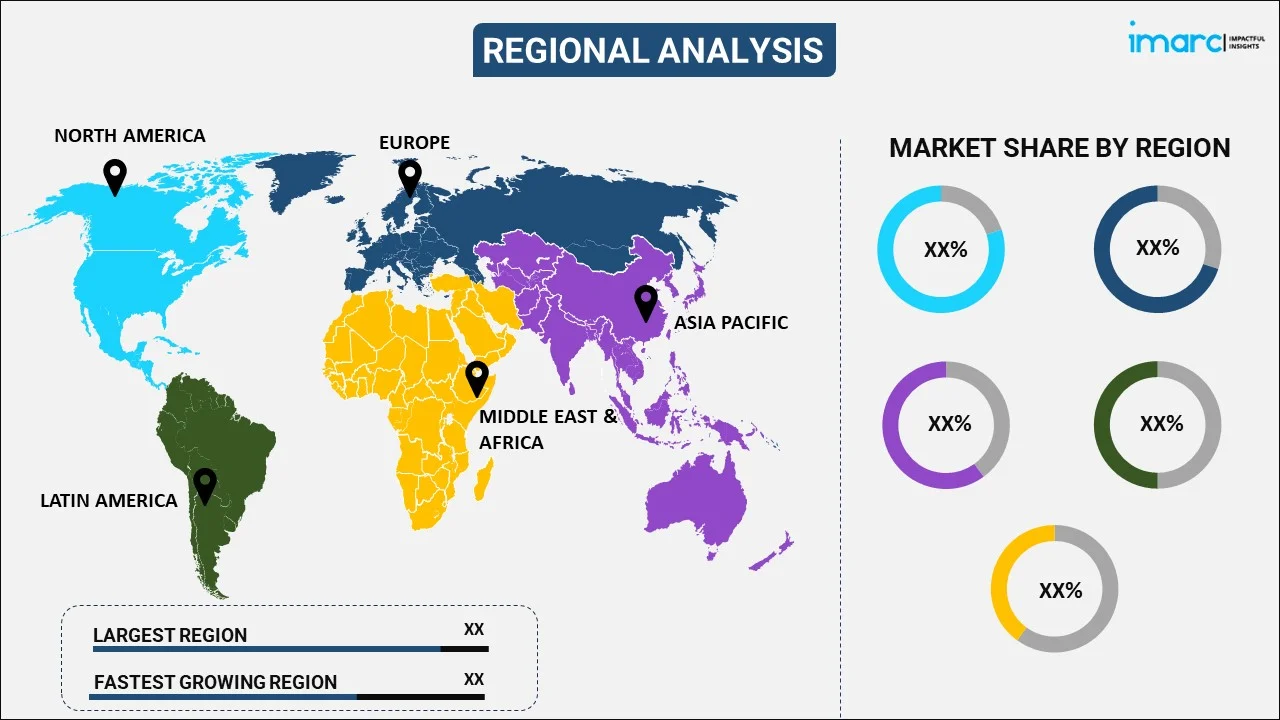
Local Anesthesia Drugs Market Report by Drug Type (Lidocaine, Bupivacaine, Benzocaine, Ropivacaine, Prilocaine, Chloroprocaine, and Others), Mode of Administration (Injectables, Surface Anesthetic), Distribution Channel (Hospital Pharmacy, Pharmacy Stores, and Others), and Region 2025-2033
Local Anesthesia Drugs Market Size:
The global local anesthesia drugs market size reached USD 3.1 Billion in 2024. Looking forward, IMARC Group expects the market to reach USD 4.3 Billion by 2033, exhibiting a growth rate (CAGR) of 3.52% during 2025-2033. The increasing surgical procedures, growing geriatric population susceptible to chronic ailments, rising government healthcare spending, and rising prevalence of chronic diseases requiring frequent medical interventions are the major factors impelling the market growth.
|
Report Attribute
|
Key Statistics
|
|---|---|
|
Base Year
|
2024
|
|
Forecast Years
|
2025-2033
|
|
Historical Years
|
2019-2024
|
| Market Size in 2024 | USD 3.1 Billion |
| Market Forecast in 2033 | USD 4.3 Billion |
| Market Growth Rate (2025-2033) | 3.52% |
Local anesthesia drugs are chemical compounds producing anesthesia by inhibiting the excitation of nerve endings or blocking conduction in peripheral nerves. They are generally available as topical creams or administered via injections or sprays during minor surgeries, biopsies, dental care, labor and delivery, and obstetrical procedures. They help treat painful conditions, such as mouth ulcers and sore throat, and relieve itching caused by cuts, minor burns, sunburns, scratches, insect bites, and poison ivy. They also assist in rapid and effective pain relief during gastritis, esophagitis, hiatus hernia, and heartburn of peptic ulcer, thus contributing to the market growth.

Local Anesthesia Drugs Market Trends:
Rising Surgical Procedures
The increasing number of surgeries performed globally is a key factor driving the growth of the local anesthesia drugs market. According to the International Diabetes Federation (IDF) forecasts, by the year 2045, about 783 million adults, or one in every eight, will have diabetes, marking a 46% increase from current figures. This increase is linked to the growing prevalence of chronic diseases, trauma cases, and elective surgeries such as cosmetic and dental procedures. Moreover, local anesthesia is preferred in various surgeries as it allows patients to remain conscious while numbing specific areas, reducing the risk associated with general anesthesia. Besides, advancements in minimally invasive surgical techniques have increased the need for effective local anesthetics, as these procedures often involve smaller incisions and shorter recovery times, making them more appealing to patients and healthcare providers, thus surging the local anesthesia drugs market demand.
Growing Geriatric Population
The global increase in the geriatric population is another significant driver of the local anesthesia drugs market. According to the United Nations (UN) prediction, the global population of individuals aged 65 and older will double in the next three decades, increasing to 1.6 Billion by 2050. At that time, older adults will make up over 16% of the world's total population. As people age, they become more susceptible to medical conditions that often require surgical interventions, including joint replacements, cataract surgeries, and cardiovascular procedures. Additionally, as many of these surgeries are less invasive and can be performed using local anesthesia, the demand for anesthetic drugs is rising among this demographic. Moreover, older adults often have higher surgical risks, making local anesthesia a safer alternative compared to general anesthesia, which can pose greater health risks, particularly in elderly patients with comorbidities. Furthermore, the increasing number of surgeries targeting age-related conditions and the growing preference for local anesthesia in such procedures are expected to propel the market growth.
Increasing Government Healthcare Spending
The rising government healthcare expenditures are playing a crucial role in the growth of the local anesthesia drugs market. Several countries are increasing their healthcare budgets to improve access to medical services, including surgical care. According to the Centers for Medicare & Medicaid Services, the national health expenditures (NHE) increased by 4.1%, reaching USD 4.5 Trillion in 2022, which amounts to USD 13,493 per individual and represented 17.3% of the gross domestic product (GDP). Moreover, medicare spending increased by 5.9% to USD 944.3 Billion, accounting for 21% of total NHE, while Medicaid spending grew by 9.6% to USD 805.7 Billion, making up 18% of total national health expenditures (NHE). Along with this, a portion of this budget is allocated to surgeries, and with greater financial resources, hospitals, and clinics are better equipped to perform a wider range of procedures, including those requiring local anesthesia. Moreover, in March 2023, the Food and Drug Administration (FDA) released a draft guidance for the development of local anesthetic drug products with prolonged duration of effect. This guidance offers the agency’s latest advice on drug development and clinical trial design considerations pertinent to local anesthetic products designed for extended-duration effects, targeting submissions for new drug applications (NDA). Besides, several governments, particularly in emerging economies, are focusing on expanding healthcare infrastructure, increasing access to surgical services, and enhancing patient outcomes, further escalating the demand for anesthesia drugs. As healthcare systems continue to grow and modernize, supported by increased government spending, the use of local anesthetics in surgeries will likely influence the local anesthesia drugs market share.
Local Anesthesia Drugs Market Segmentation:
IMARC Group provides an analysis of the key trends in each sub-segment of the global local anesthesia drugs market report, along with forecasts at the global, regional and country level from 2025-2033. Our report has categorized the market based on drug type, mode of administration and distribution channel.
Breakup by Drug Type:

- Lidocaine
- Bupivacaine
- Benzocaine
- Ropivacaine
- Prilocaine
- Chloroprocaine
- Others
Breakup by Mode of Administration:
- Injectables
- Surface Anesthetic
Breakup by Distribution Channel:
- Hospital Pharmacy
- Pharmacy Stores
- Others
Breakup by Region:

- North America
- United States
- Canada
- Asia-Pacific
- China
- Japan
- India
- South Korea
- Australia
- Indonesia
- Others
- Europe
- Germany
- France
- United Kingdom
- Italy
- Spain
- Russia
- Others
- Latin America
- Brazil
- Mexico
- Others
- Middle East and Africa
Competitive Landscape:
The report has also provided a comprehensive analysis of the competitive landscape in the global local anesthesia drugs market. Detailed profiles of all major companies have also been provided. Some of the companies covered include:
- Aspen Pharmacare Holdings Limited
- B. Braun Melsungen AG
- Baxter International Inc.
- Endo International plc
- Fresenius SE & Co. KGaA
- Hikma Pharmaceuticals plc
- Pacira Biosciences Inc.
- Pfizer Inc.
- Pierrel S.p.A.
- Septodont
Kindly note that this only represents a partial list of companies, and the complete list has been provided in the report.
Local Anesthesia Drugs Market News:
- On 25 September 2024, Heron Therapeutics, Inc., a commercial-stage biotechnology company, announced that the U.S. Food and Drug Administration (FDA) has approved its Prior Approval Supplement Application for the ZYNRELEF (bupivacaine and meloxicam) extended-release solution Vial Access Needle (VAN). ZYNRELEF stands as the first and only dual-action local anesthetic that provides a set combination of the local anesthetic bupivacaine and a low dose of the nonsteroidal anti-inflammatory drug, meloxicam. It is set to replace the existing vented vial spike, the VAN is designed to streamline aseptic preparation and substantially shorten the withdrawal time for ZYNRELEF to between twenty and forty-five seconds. The VAN's user-friendly container-like design is expected to enhance safety, increase its adoption, and improve the overall preparation process. The launch of the VAN is anticipated in the fourth quarter of 2024.
Local Anesthesia Drugs Market Report Scope:
| Report Features | Details |
|---|---|
| Base Year of the Analysis | 2024 |
| Historical Period | 2019-2024 |
| Forecast Period | 2025-2033 |
| Units | Billion USD |
| Segment Coverage | Drug Type, Mode of Administration, Distribution Channel, Region |
| Region Covered | Asia Pacific, Europe, North America, Latin America, Middle East and Africa |
| Countries Covered | United States, Canada, Germany, France, United Kingdom, Italy, Spain, Russia, China, Japan, India, South Korea, Australia, Indonesia, Brazil, Mexico |
| Companies Covered | Aspen Pharmacare Holdings Limited, B. Braun Melsungen AG, Baxter International Inc., Endo International plc, Fresenius SE & Co. KGaA, Hikma Pharmaceuticals plc, Pacira Biosciences Inc., Pfizer Inc., Pierrel S.p.A. and Septodont |
| Customization Scope | 10% Free Customization |
| Post-Sale Analyst Support | 10-12 Weeks |
| Delivery Format | PDF and Excel through Email (We can also provide the editable version of the report in PPT/Word format on special request) |
Key Benefits for Stakeholders:
- IMARC’s industry report offers a comprehensive quantitative analysis of various market segments, historical and current market trends, market forecasts, and dynamics of the local anesthesia drugs market from 2019-2033.
- The research report provides the latest information on the market drivers, challenges, and opportunities in the global local anesthesia drugs market.
- The study maps the leading, as well as the fastest-growing, regional markets. It further enables stakeholders to identify the key country-level markets within each region.
- Porter's five forces analysis assists stakeholders in assessing the impact of new entrants, competitive rivalry, supplier power, buyer power, and the threat of substitution. It helps stakeholders to analyze the level of competition within the local anesthesia drugs industry and its attractiveness.
- The competitive landscape allows stakeholders to understand their competitive environment and provides insight into the current positions of key players in the market.
Key Questions Answered in This Report
The global local anesthesia drugs market was valued at USD 3.1 Billion in 2024.
We expect the global local anesthesia drugs market to exhibit a CAGR of 3.52% during 2025-2033.
The rising prevalence of cardiovascular, respiratory, and other chronic diseases, along with the growing number of individuals undergoing surgical interventions that require post-operative pain relief, is primarily driving the global local anesthesia drugs market.
The sudden outbreak of the COVID-19 pandemic has led to the increasing utilization of local anesthesia drugs to treat painful conditions, such as sore throat, which is a major symptom of the coronavirus disease.
Based on the drug type, the global local anesthesia drugs market can be categorized into lidocaine, bupivacaine, benzocaine, ropivacaine, prilocaine, chloroprocaine, and others. Currently, lidocaine accounts for the majority of the global market share.
Based on the mode of administration, the global local anesthesia drugs market has been segregated into injectables and surface anesthetic, where injectables currently hold the largest market share.
Based on the distribution channel, the global local anesthesia drugs market can be bifurcated into hospital pharmacy, pharmacy stores, and others. Currently, hospital pharmacy exhibits a clear dominance in the market.
On a regional level, the market has been classified into North America, Asia-Pacific, Europe, Latin America, and Middle East and Africa, where North America currently dominates the global market.
Some of the major players in the global local anesthesia drugs market include Aspen Pharmacare Holdings Limited, B. Braun Melsungen AG, Baxter International Inc., Endo International plc, Fresenius SE & Co. KGaA, Hikma Pharmaceuticals plc, Pacira Biosciences Inc., Pfizer Inc., Pierrel S.p.A., and Septodont.
Need more help?
- Speak to our experienced analysts for insights on the current market scenarios.
- Include additional segments and countries to customize the report as per your requirement.
- Gain an unparalleled competitive advantage in your domain by understanding how to utilize the report and positively impacting your operations and revenue.
- For further assistance, please connect with our analysts.
 Inquire Before Buying
Inquire Before Buying
 Speak to an Analyst
Speak to an Analyst
 Request Brochure
Request Brochure
 Request Customization
Request Customization




.webp)




.webp)












